The first step in carrying out any sort of research is identifying the research gap. Choosing an unexplored area in your research field will enable the smooth and successful completion of your research work with a good number of publications. But the big question is, how to identify the research problem from the existing literature. Some researchers have a clear idea about the research problem they want to pursue. However, some researchers, especially those who are at an early stage of their career, find it difficult to choose a research problem that is unique and novel. So, the best way to handle this is to identify the gap in existing research i.e., identifying the research gap!
In this article, iLovePhD explains the research gap and discusses six important tips to identify the gap.
What is a Research Gap?
- A research gap is a problem or a question that has not been answered by any of the existing studies within your area of research.
- For instance, when you read a research or review article on topics of your research interest, you may notice some areas have significant scope for more research but they have not been explored by other researchers.
- So, a research gap or a literature gap refers to such unexplored areas that have scope for further research.
Significance of Unique Research Gap
- Assume that you have completed all your experimental works and you are in the process of publishing your findings in reputed journals.
- But the journal editors keep rejecting your paper stating that the research work is not unique and novel.
- Knowing this information then would be distressing for you.
- Therefore, it is important to find out the unique and novel research problems which have not been answered before.
- Remember you are investing your time, knowledge, funds, and resources in the research.
- So, invest in the right work which enables you to publish your research findings quickly.
How to Identify Research Gap?

Here are the 6 effective tips to identify the research gap.
1. Understand the Existing Literature:
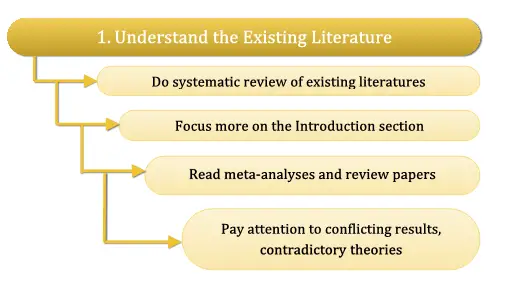
The first step in gap analysis is to do a systematic review of existing literature relevant to your research. A comprehensive literature survey would provide a clear understanding of the existing works. Conduct a systematic review of relevant scholarly articles, books, conference papers, and other reliable sources. This will not only help you to understand the depth of work but also provide an opportunity to ask questions that can lead you to identify research gaps.
Also Read: How to Write a Literature Review?
When you are reading research articles, focus more on the Introduction section where the authors explain the importance of their research and the gaps they have identified and attempted to fill through their research. Reading review articles on a particular area of research is more important and also it is the easiest way to understand the gap in your research in a short time. Read meta-analyses and review papers to learn more about the developments and trends in research over the years in your field of research.
Pay attention to areas where there are conflicting results, contradictory theories, or unanswered questions. These areas often indicate potential research gaps that you can explore further.
It is always a good practice to note all the questions that cross your mind while reading articles. You can use tables, charts, or tools to record this. You know, it will help you in the long run when you are developing your idea into a research problem or even when writing your manuscript.
2. Skim-read the Existing Literature
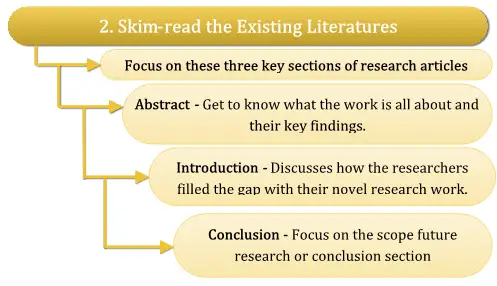
Skim-reading the literature in the sense, you don’t need to read the articles from start to end. Instead, you need to focus on these three key sections. They are:
Abstract – Here you will get to know what the work is all about and their key findings.
Introduction – It will give you more detail about the context and background of the study, as well as how the researchers filled the gap with their novel and unique research work.
Conclusion – Another useful way to find a research gap is to focus on the recommendations for future research or the conclusion section in the research or review article. It will give you directions or suggestions for future research that could be highly interesting and inspiring.
By skimming through these three sections of any research and review article, you will gain a reasonable idea of what each study was about, without taking much of your time.
3. Search for “FRIN phrase”
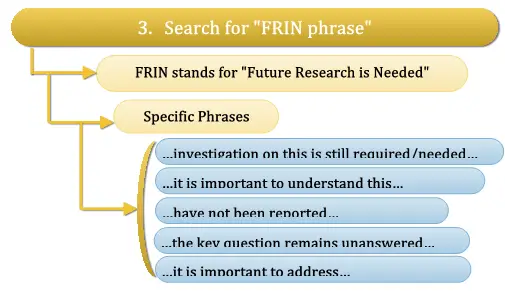
FRIN stands for “Future Research is Needed”. This is an easy method to identify the research gap. You will have to search for a few specific phrases in the articles you read. The phrases are
…investigation on this is still required/needed….
…it is important to understand this…
…have not been reported…
…the key question remains unanswered…
…it is important to address…
These expressions indicate the gaps or issues related to the main question that still need extensive scientific study. Therefore, it is important to take notice of them and use this information to develop novel research that is worth exploring.
4. Get Feedback from the Supervisor

Discuss the issues and problems with your research Supervisor or advisor to get their suggestions. These conversations can provide valuable insights and help you to refine your research focus. They can help you to identify the blind spots in your thinking.
5. Use digital tools to Identify Research Gap
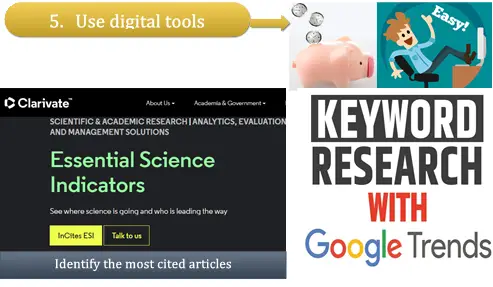
You can use digital tools as they can save time and make your search easy. Tools like Essential Science Indicator – identify the most cited articles in your field to know which topics are considered important. You can also use Google Trends to learn more about the popular questions related to your research area. This will ease your search for an unexplored area.
6. Conduct a Laboratory-scale Study:
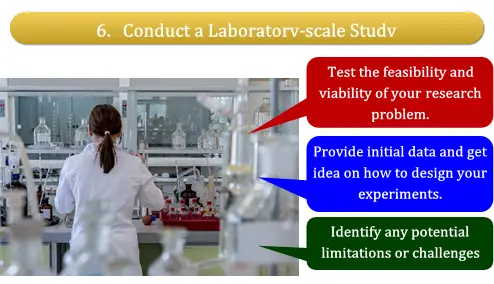
Consider conducting a laboratory-scale study to test the feasibility and viability of your research problem. A lab-scale study will provide you with initial data and you also get an idea on how to design your experiments. It can help you to identify any potential limitations or challenges that need to be addressed before undertaking a full-scale research study.
Also Read: Comparison Between Laboratory-Scale, Pilot-Scale, and Full-Scale Studies in Research
How to Evaluate Potential Research Gaps?
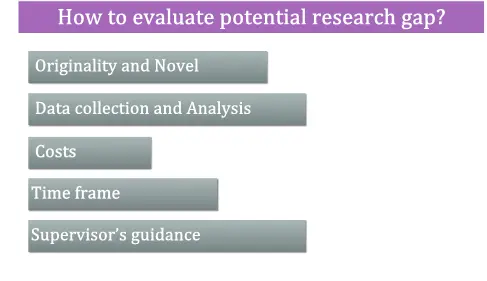
Once you have a list of potential research gaps that could be explored, you need to systematically evaluate them to choose a good research problem. This will help you to avoid duplication of work. The key factors to be considered are listed here.
Originality and Novel – You need to ensure that the research problem should be original, unique, and novel.
Data Collection and Analysis – You need to check whether the data collection and sampling methods are easy and feasible. Also, check the instrumentation facilities are available for the study.
Costs – Check for any additional costs involved in data collection and analysis.
Time frames – Check that you can complete the research works within the timeframe specified by your university.
Supervisor’s guidance – The most important factor is, to ensure that your supervisor is comfortable in guiding you in your chosen topic throughout your research work.
Different types of research gaps in the literature review
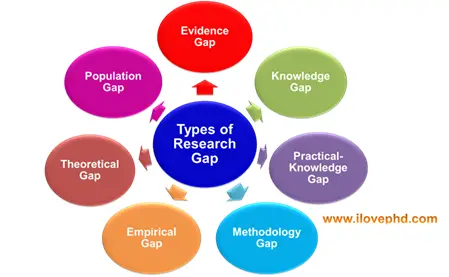
According to Robinson, Saldanhea & McKoy (2011), Muller-Bloch, & Kranz (2015), and Miles (2017), the research gap has been classified into seven categories.
Evidence gap: Little or no evidence to address the research problem.
Knowledge gap: Knowledge may not exist in the actual field. It might be the case that the result of a study differs from what was expected.
Practical-Knowledge gap: When professional behavior or practices deviate from research findings or are not covered by research.
Methodology gap: A distinction in research methods is needed to have new insights or to avoid ambiguous findings.
Empirical gap: Research findings need to be evaluated or empirically verified.
Theoretical gap: Theory should be applied to certain research issues to generate new insights; a lack of theoretical knowledge may lead to a gap in research.
Population gap: Type of research gap that deals with a population that is not adequately represented or under-researched in the prior research (Eg., Gender, age, race).
Conclusion
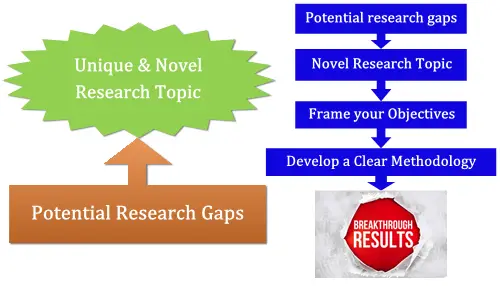
By following the above-said tips, I am sure that you can very well identify the research gaps in your area of research. Unique research topics emerge from research gaps, so it’s important to do a gap analysis before you attempt to define a topic. Once you have identified a potential research gap and resultant topic, frame your objectives, then develop a clear methodology, and carry out your experiments, and this will certainly lead to breakthrough results.

